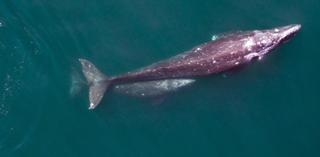May 29 2015
One recent spring day, John Durban, a NOAA Fisheries marine mammal biologist, stood on the California coast and launched an unmanned aerial vehicle into the air.
 A gray whale and her calft migrate north along the California coast on their way to summer feeding grounds in the Arctic. Credit:NOAA
A gray whale and her calft migrate north along the California coast on their way to summer feeding grounds in the Arctic. Credit:NOAA
The hexacopter--so called because it has six helicopter-type rotors--zipped over the ocean and hovered above a gray whale mother and her calf. The pair was migrating north from their calving grounds off Baja California, Mexico, to their summer feeding grounds in the Arctic.
NOAA Fisheries scientists have stood at this point of land each year for the past 22 years, binoculars in hand, to estimate the number of gray whale calves born each year. That's an important step in monitoring the ups and downs of the population. But scientists would like to understand more completely what causes those ups and downs, and this year, with the addition of the hexacopter, they hope to find out.
As the hubcap-sized hexacopter hovered high above the whales it shot straight-down photos from a digital camera mounted in its belly. In addition to a camera, the hexacopter also carried a very precise pressure altimeter, allowing scientists to know the exact altitude at which each image was taken. Later in the lab, they would analyze the images, measuring the length and girth of the whales to within a few centimeters.
"We can't put a gray whale on a scale, but we can use aerial images to analyze their body condition--basically, how fat or skinny they are," Durban said.
Durban and co-pilot Holly Fearnbach, also a NOAA Fisheries scientist, would ultimately capture images of more than 60 cow/calf pairs.
A Long and Difficult Journey
The amount of fat on a gray whale cow is critical to the survival of her calf. Gray whales don't feed during most of their months-long migration, and while the mothers are fasting, they're also nursing their fast-growing calves. Therefore they need a lot of blubber to fuel the journey to their Arctic feeding grounds.
How much blubber they're carrying depends in part on conditions in the Arctic the summer before. If the whales had access to plentiful prey, the cows will have sufficient fat on them, and most calves will likely survive the journey. But if conditions weren't favorable, fewer calves will be born, and fewer still will make it.
"By studying the body condition of females, we hope to connect the dots between conditions in the Arctic one year and calf production the next," Durban said. "Ultimately, we're trying to understand how environmental conditions affect the reproductive success of the population."
Throughout the study, scientists kept the hexacopter at least 120 feet above the whales. When used at this altitude by trained scientists, unmanned aerial vehicles offer a safe and non-invasive way to collect important data on marine mammals and other protected species.
A Recovery Success Story
Gray whales were hunted nearly to extinction during the whaling days. Thanks to legal protections, the U.S. population of gray whales recovered and was taken off the endangered species list in 1994 (though a second population of gray whales on the Russian side of the Pacific remains endangered).
This success presents scientists with a unique opportunity to study the ecology of large whales, including how environmental conditions put an upper limit on population growth. Because most other large whales are still threatened or endangered, scientists have had few opportunities to observe these dynamics in action.
"With gray whales, we're just beginning to understand what a recovered population of large whales looks like," Durban said.
This understanding will help scientists set recovery goals for other species. And once a species is recovered, it will help scientists distinguish between normal ups and downs in a population and signs of--should it happen--a more serious decline.
"We'll have to get used to seeing recovered populations have good years and bad years," Durban said. "That's what happens when you've recovered and you're hovering around a food ceiling."
As the sun descended toward the horizon, Durban brought the hexacopter in for the day's final landing. He still had a lot of work in front of him, minutely analyzing images on a computer screen. Though all the images from this study would be of gray whales, other species of large whale are also showing promising signs of recovery.
"Hopefully in the not-too-distant future," Durban said, "there will be many healthy populations of large whales to study."